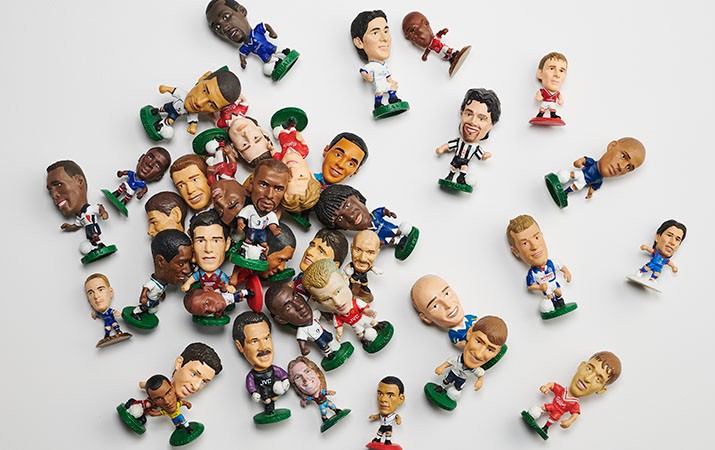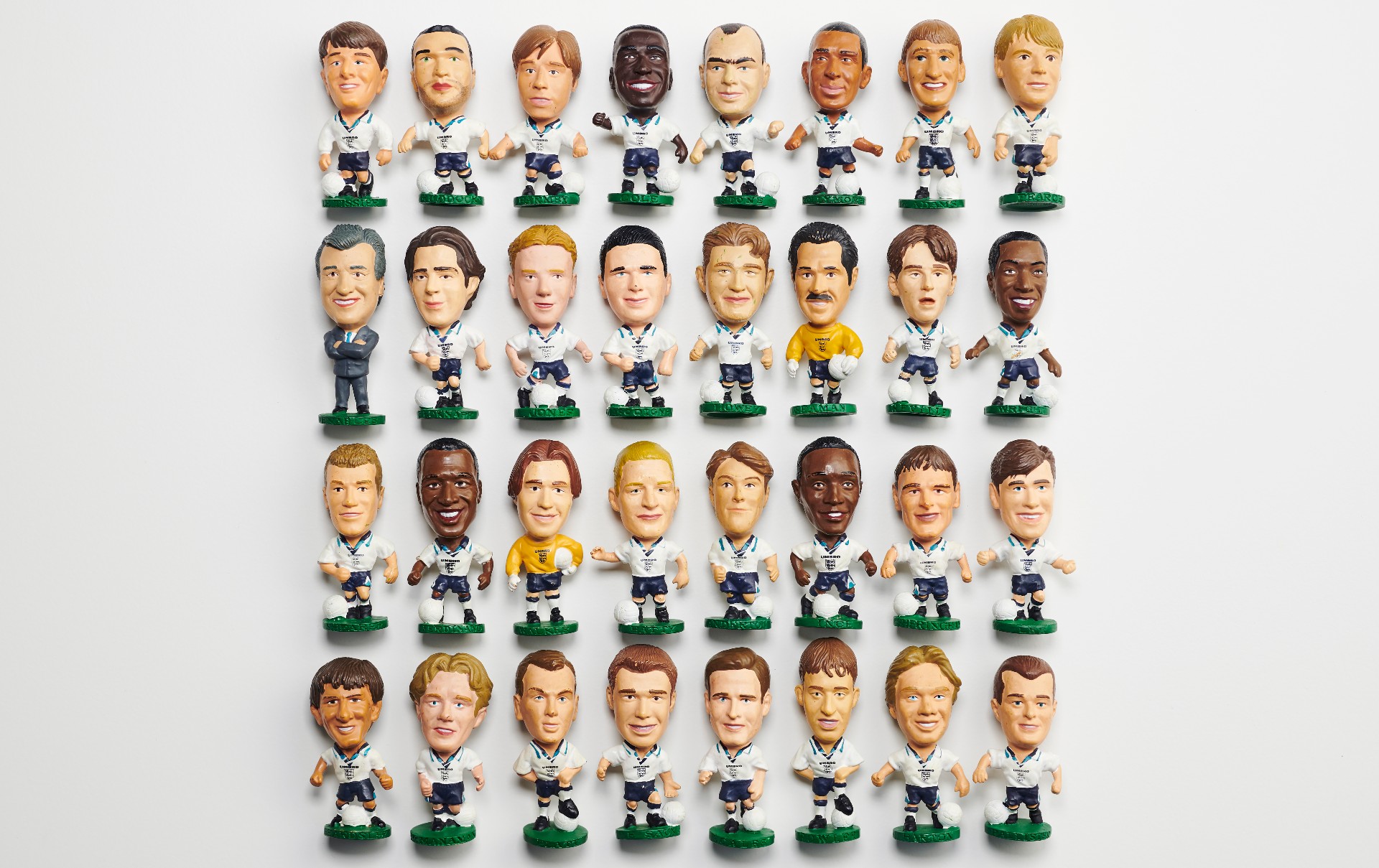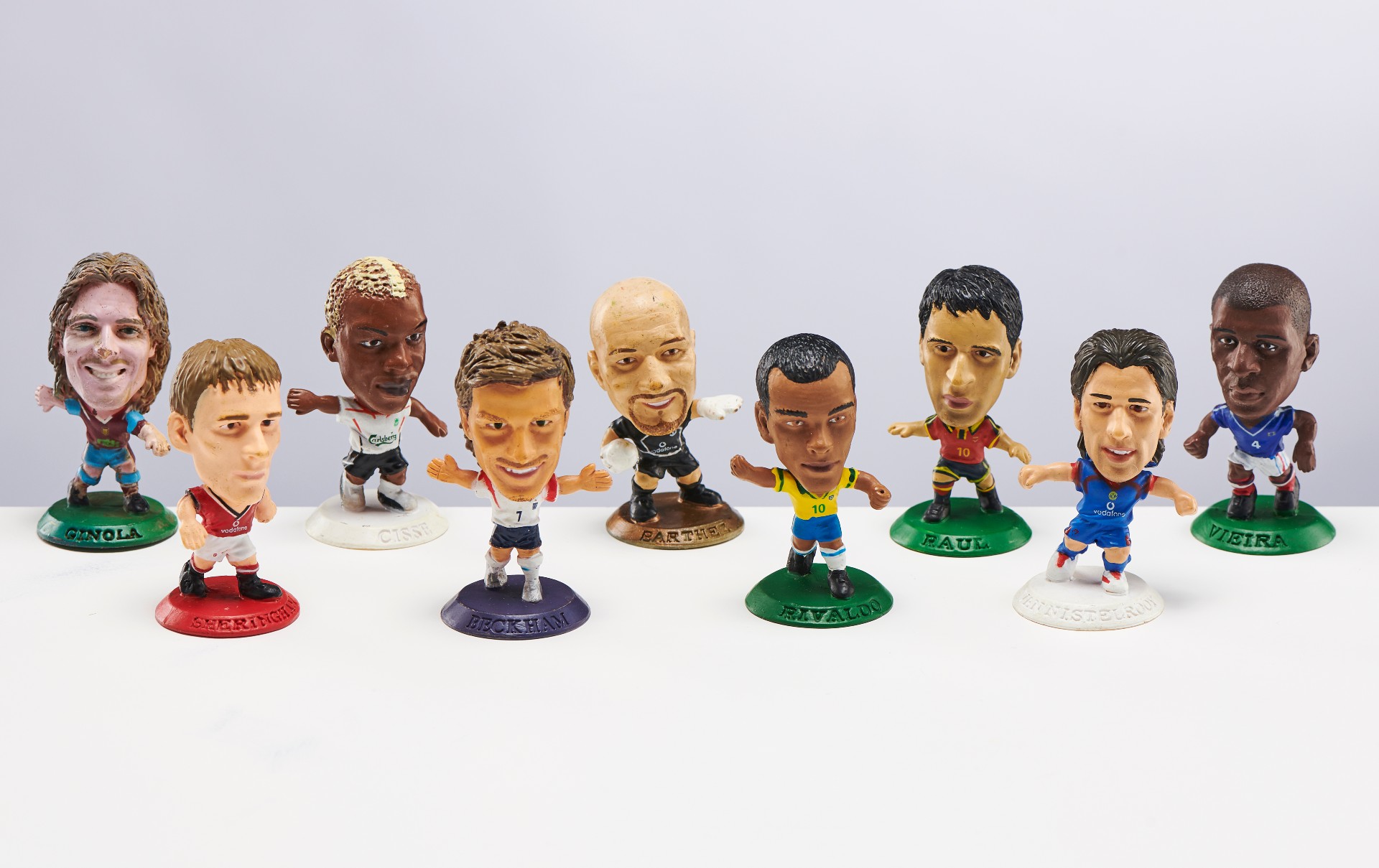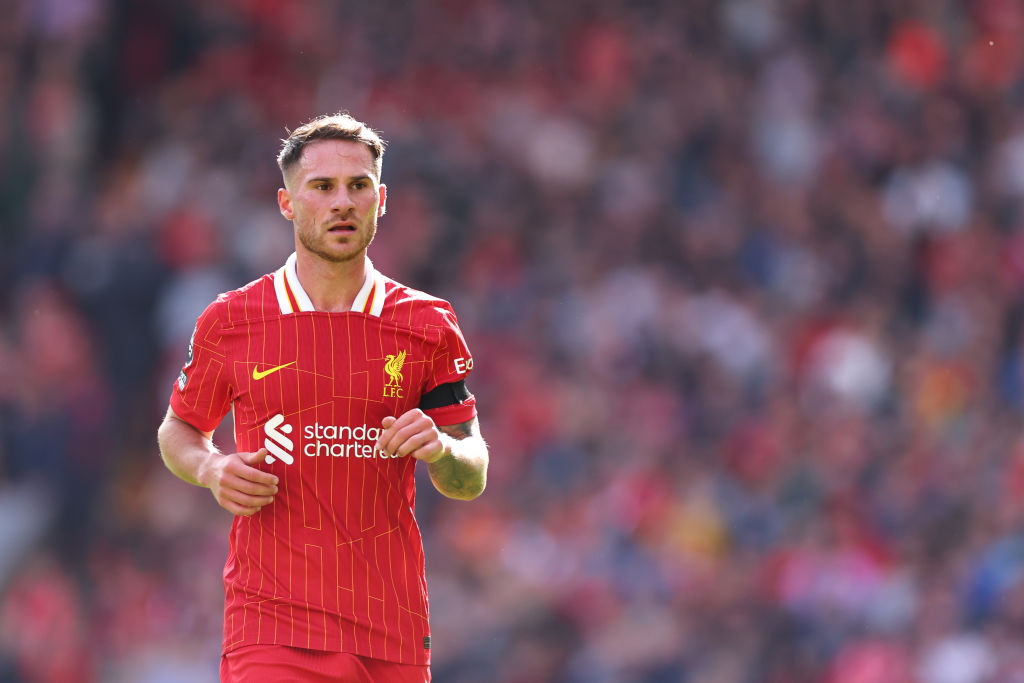Corinthian figures: how the big-headed football collectibles took the world by storm
In the late 1990s, big-headed collectibles known as Corinthian figures stormed onto British shelves, then quickly flew off them. This is the tale of how Corinthian figures dominated for half a decade, told by those at the top – it all started with Star Trek...

This feature first appeared in the March 2021 issue of FourFourTwo magazine. Subscribe now!
Corinthian figures had it all going for them in English football’s favourite decade: they were more upmarket than Merlin Premier League stickers, more collectible than Subbuteo and less likely to aggravate your mum than those constant pleas for Bull Boys shoes.
The 1990s is littered with such sepia-tinged memories of innocence, not least thanks to the 7cm plastic masterpieces which helped immortalise players from Gianfranco Zola to John McGinlay, and were snapped up in their millions following their launch in October ’95.
It could have all been so different, though. Had it not been for an assist from none other than Mr Spock, they may never have seen the light of day...
Blind bags, Zizou parties and Gazza haircuts
Their name is synonymous now as ‘bigheads’, but Corinthian PLC began life in the 1980s as a promotional gifts company which made the freebies contained inside boxes of Tetley tea bags and McDonald’s Happy Meals. When a 1993 row between China and the EU regarding non-human toy imports ruined their best-laid plans, however, they were scrambling around for fresh ideas.
“A cereal company wanted to do a promotion around Star Trek, so we suggested figures of the main characters,” co-founder Paul Speed explains to FourFourTwo. “We sent them off for approval from Customs and Excise, but they said Spock was non-human because he was a Vulcan. These tariff quotas were strictly enforced, so we had to find something that we could import freely without restrictions.”
With the freshly-formed Premier League enjoying early success, Speed came up with the idea of creating football figurines inspired by Spitting Image. “We messed around with several sizes and designs, but felt they had to be small to keep the cost down and make them collectible,” he continues. “We opted for caricatures because they were faster and cheaper to make, and when we showed the prototypes to the office, it was obvious that the big-headed versions were the favourites.
Get FourFourTwo Newsletter
The best features, fun and footballing quizzes, straight to your inbox every week.
“We produced four to begin with – Robbie Fowler, Peter Schmeichel, Alan Shearer and Ryan Giggs. Once we started showing them to the main retailers, we knew we were on to something. I remember seeing a buyer from Woolworths and putting the four figures on her desk. She asked me, ‘What do they do?’ When I told her they didn’t do anything, she was sceptical – but within five minutes, 10-15 male buyers had passed by saying she had to have them.”
With orders racking up, the manufacturing process got underway.
“We’d find pictures of a player from various angles, then picked an expression and hairstyle that we liked,” says Paul Stinchcombe, former chief executive of the company and a school friend of Speed. “We sent those off to the sculptors and they created a clay prototype which we reviewed, then requested approval by the club, player or agent. From that, we made a master version which was passed on to a factory in China to mass produce them.”
In late ’95, 16 members of Terry Venables’ England squad were first off the production line. Branded as Headliners, they proved an instant hit with supporters and their real-life inspirations alike.
“Our office was in High Wycombe, just up the road from where England used to train, so we’d go there and take photographs of the players with their figures,” says Stinchcombe. “They seemed to like them; after we showed Paul Gascoigne his model, he dyed his hair blond the next day, which he found hilarious.” Out of adversity comes opportunity, though, and within weeks 5,000 blond-haired Gazzas were in production as collector’s editions, to boost Corinthian’s bank balance.
“We released England first in October, then Manchester United and Liverpool followed in mid-November,” recalls Speed. “They all sold in phenomenal numbers and shops couldn’t keep them on the shelves. We flogged about 5,000 England packs, and when Manchester United came out it went absolutely ballistic. Not long after the launch, I remember having to sign United a royalties cheque for several hundred thousand pounds.”

‘Bigheads’ were a big hit, and soon fans of each Premier League club could snap up their favourite stars.
“It took 13-14 months until we had every team signed up,” says Speed. “At the time there were approximately 4,000 independent toy stores in the UK and nearly all of them took our product. We’d targeted boys aged up to 12 but quickly realised we were appealing to anyone who liked football from four to 94. We used to do business with banks in the city and half of the traders had figures stuck on top of their monitors.”
For Patrick Short – a super collector with an army exceeding 5,000 players – seeing them in the shops kick-started a lifelong obsession.
“My mum made me a birthday cake shaped like a football pitch and told me to pick two figures to sit on the top,” he reminisces to FFT. “I went for Shearer and Neville Southall and it snowballed from there. It was the first time you could hold your favourite player in your hand. Stickers had to be put in a book but you could play matches with these. If I went into a shop that had them, I had to buy some.”
Like a Tony Yeboah volley, the immediate fervour and affection caught Corinthian off guard.
“We had a tiger by the tail,” explains Speed. “The magnitude of sales was incredible but it was quite a hairy period. The lead time for production was 12 weeks from placing an order to when goods arrived in the UK.”
“We underestimated the time lag, ending up with too many of the wrong players at the wrong time,” remembers Stinchcombe. “Regionality was often an issue – you’re not going to sell many Arsenal figures in Newcastle or Aston Villa figures in Brighton. To get around this, we sold them in a blind bag. If kids got a player they didn’t want, they could swap it in the playground.”
Once again, Corinthian had stumbled upon an ingenious way of peddling more of their models to football-crazed children – although some would be left disappointed with what they found upon ripping open the packaging. For every David Ginola, instantly recognisable with his flowing jet-black hair and designer stubble, there was an adolescent Lee Bowyer bearing a resemblance to Victor Meldrew; or Paul Warhurst looking like that bloke in the pub you desperately avoid eye contact with.
“The sculpts did improve over time,” laughs Speed. “We learned that the uglier or more distinctive features a player had, the easier they were to make. We didn’t set out trying to emphasise a particular feature like a chin or nose – we tried to sculpt them as close to the real thing as possible.
“Dreadlocks were always difficult – we had to do Henrik Larsson five or six times before we finally got it right! Some players asked to change this and that, which we did, but we didn’t find anyone to be annoyed or arrogant about having their figures done. Instead, the players wanted them done because it made them feel like they’d made it.”
While global stars such as Eric Cantona and Ruud Gullit proved most popular, an unlikely idol was championed by Stinchcombe.
“My personal favourite model was Gary Penrice from QPR,” he chuckles. “I thought it looked spot on and we used it as the standard we needed to get to. Players have always been a fan of them. We once got a call from Real Madrid, who wanted some because Zinedine Zidane was having a party for his son, and Stuart Pearce also phoned up asking where he could get them.”
“I saw a video of Dennis Bergkamp showing people around his house, and he had a load of his Corinthian figures up on display,” adds collector Short. “Not long ago, Billy Sharp slid into my DMs and bought some off me.”
Becks and the beginning of the end
It wasn’t all plain sailing, though: players’ life decisions could have huge consequences for the company.
“We had three main issues: kit changes, transfers and haircuts,” says Speed. “You could plan around new kits, and haircuts actually provided more opportunity – David Beckham was a nightmare because he often changed his hairstyle, but each time he did it generated fresh demand for the latest figure. I think we produced about 12 different ones for Beckham in all.
“Transfers were the main headache for us. When Beckham joined Real Madrid in 2003, we had to scrap thousands of figures of him in Manchester United kits. One of the most famous ones was when Tore Andre Flo went from Chelsea to Rangers. We just managed to stop production before they packaged the bulk of the blind packs, but some models of him wearing a Chelsea kit still slipped through the net – they’ve become quite valuable and fetch a handsome price.” Indeed, Flo’s 2001 Chelsea figure is one of the most sought-after in Corinthian’s history.
With business booming, the company eyed multiple markets. Brief forays into cricket and rugby didn’t have the same effect in the UK, but they found success in America producing figurines of NFL, MLB, NBA and NHL players – so much so that the Headliners brand, including the name, was sold to a US-based enterprise. That led to the launch of Corinthian Prostars, with new and improved sculpting techniques propelling the firm to a higher level in terms of quality and profitability.
Another factor behind their popularity was that its arrival coincided with the rise of the internet, allowing connoisseurs from all four corners of the globe to find rare figures from the comfort of their homes. It’s a community currently enjoying a renaissance too, after boxes of long-lost models were uncovered in attics during lockdown.
“My dad used eBay when it was fairly new and made a heap of foreign contacts,” says Short. “One day I came home from school to discover the most ’90s package from Japan imaginable, containing a full set of Japanese Headliners, Dennis Rodman figures with a few different hair colours, a Mew Pokémon card and a Hidetoshi Nakata shirt. I’m still hooked today – recently, I bought a Nicola Amoruso Juventus Headliner for £125 which was well worth the money. Don’t tell my wife, though.”
As Speed reveals, however, the rarest figure released isn’t even a footballer... or indeed, human. “We did a promotion with Televisa – a televison company in Mexico – who asked us to make a pitchside camera on a tripod,” he recalls. “They only wanted a hundred or so, but apparently that’s the most valuable figure and sells for several hundred pounds.”
In their next venture, Corinthian shrank Prostars to create Microstars, then encased them in chocolate to form Powerpodz – akin to a Kinder Surprise.
“Places like Woolworths only had a limited amount of space for toys, except at Christmas,” reflects Stinchcombe. “To get our products in stores all year long, they suggested doing a confectionary item. The chocolate factory believed the success of Microstars wasn’t down to the figures, but the quality of their chocolate...”
At that time, Speed was getting worried.
“Nothing quite hit the heights of the original Premier League collection, and things began to fade away by the end of 1998,” he admits. “We were forced to bring out Microstars as the toy companies lost interest – kids had moved on to the next big thing. We tried to turn Prostars into a collectible range and reduced the production quantities, but the number of collectors wasn’t large enough to justify continuing making them.”

As the 2000s rolled on, Corinthian’s football figures found themselves in a similar position to one-cap wonder Seth Johnson: formerly flavour of the month; now a millstone around the firm’s neck. “The business had started to evolve into a mainstream toy company, and there was less focus on the football figures,” says Stinchcombe. “They became neglected, and I was partly to blame for it because I felt they’d run their course.”
In 2008, a perfect storm of falling interest and the financial crisis effectively led to the sudden demise of Corinthian PLC, and thus Prostars and Microstars.
“We needed quite a lot of money from the bank to keep making all the figures, because there were pretty long lead times,” explains Stinchcombe. “The bank told us that unless we as owners put up our houses as personal guarantees, they would have to withdraw our bank facility. We’d all done very well out of the company, so basically called their bluff and stepped away. We had a hefty debt from Woolworths after they went bust, although we were always making money – when we chose to call it a day, the business had more than £1 million in the bank.”
It was the avid collectors, therefore, who were hit hardest.
“It was a sad time knowing there was going to be no more new figures, but it wasn’t much of a surprise,” concedes Short. “However, it’s nice to know there’s now a set number I need to complete them all, rather than worrying about extra releases.”
The rollercoaster ride had finally come to an end, but Stinchcombe has since embarked on a different one as the driving force behind Soccerstarz – pocket-sized players that share a likeness with Microstars.
Speed, meanwhile, is happy to look back on the joy he brought to football fans around the world with plenty of pride.
“I’m really proud that when I say, ‘I used to make the big-headed footballers,’ people go, ‘Oh, I used to collect those.’ We did some research and learned that 82 per cent of all boys in the UK had purchased at least four. In fact, we produced so many models that if you put them head to base, they’d stretch to the moon and back one and a half times.”
There’s a feat Spock would find impressive.
READ MORE
WATCH Got, Got, Need! The Story of Panini Stickers – a FourFourTwo Films exclusive
FEATURE How the 1990s saved English football
QUIZ Can you name the English league top scorers of the 90s?
